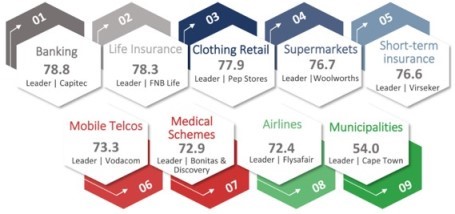“2020 looks set to be an epic fight for survival as numerous socio-economic factors come into play that will further challenge businesses and their ability to achieve greater levels of customer satisfaction in a bid to retain and grow their customer base – from a looming recession, abysmal economic growth figures, political uncertainty and a disastrous return of load shedding,” according to Consulta, a leading South African research company.

The financial services industry outcomes contain some important considerations:
Banking Industry:
South Africa’s Banking sector has the most satisfied customers of all nine industry sectors polled with an industry par score of 78.80. The leader brand in the banking sector with the most satisfied customers across all banks is Capitec (84,9).
However, the high figure of ‘1 in 4’ customers being ready to defect to another bank should be of major concern, as it suggests that established banks are not as customer centric as they believe and are likely to lose market share a lot quicker to new entrants than anticipated.
Life Insurers:
Life Insurers rank second for having the most satisfied customers with industry par of 78.3 – here FNB Life takes leader position with 83,7 and well above the industry par.
The industry needs to address the common misperception that insurers will look for reasons not to pay claims. It’s a perception that is simply not backed by the facts if you consider that the Association for Savings and Investment South Africa (Asisa) released statistics for 2018, showing that life insurers paid 99.3% of the value of all claims made.
It was very revealing to note the impact that recent news reports on claims rejections and reputational blunders have had on the public image of life insurers as a whole.
Short-term Insurance
The Short-Term Insurance (STI) sector is ranked fifth of all sectors polled with an industry par of 76.6. Here Virseker leads (80,7) with the most satisfied customers.
The STI sector is being heavily tested with fierce competition amongst current players in a low growth market. New Insure-tech brands are upending traditional insurance models, as well as developing new markets that have largely been ignored by insurers.
A key takeout from the SA-csi is that customers do not want to jump through hoops and expend a great deal of effort to get the cover they need or earn loyalty rewards, while complaints handling and speedy claims resolution are areas that warrant focused attention.
In particular, in an industry that has undergone significant consolidation and merger and acquisition activity over the years, insurers must avoid the temptation to look at their customer experience programmes from the constraints of their own siloed business models.
Medical Schemes
Medical schemes ranked 7th with an industry par of 72.9 – no outright leader was identified in the latest index, with Bonitas and Discovery obtaining a joint leadership position and GEMS (68,3) lagging in last place.
Satisfaction levels for medical schemes are substantially lower than those measured in other financial services industries – one of the key reasons is that the overt complexity of benefit designs does not allow for easy cost versus value correlations. Loyalty is on the decline as a result of lower price tolerance. As the economy bites and more consumers opt to downgrade their cover to lower benefit options in a bid to cut costs, they are not realigning their ‘consumption-based’ expectations and are struggling to decipher the complexity of benefit options and scheme rules.
Customers of all medical schemes polled in the 2019 Index indicated that they do not believe that the premiums paid match the quality of cover and experience on offer.
Could this be the result of the decision to cut adviser commission to the core, years ago? We have seen some schemes using technology to address the information gap, but what about those clients who are technologically challenged?
For us in the industry it is important to note these perceptions as it could severely impact on client retention.
Click here to read the blog post.



